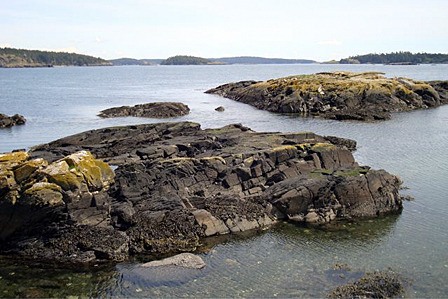by the Committee for National Conservation Area
“We’re going to hit” shouted the Captain, and within an instant the hull was smashed against the slightly submerged rocks. May Day!
For everyone from kayakers to tankers, rocks and reefs can be a navigational nightmare. The Bureau of land Management (BLM) owns more than 40 groups of exposed, submerged, and sometimes invisible rocks and reefs in the San Juans.
Though they can be a hazard, these seemingly lifeless features abound with marine life which may fluctuate with the tide. Home and resting areas for a diverse array of seabirds, rocks and reefs provide sanctuary for migrating and resident species alike. Often left alone due to their hidden dangers and unattractive human appeal, they become ideal habitat for seals and sea lions to rest during low tide and sun themselves, lazy but cautiously watching boats and kayakers float by.
Commorants, gulls, oyster catchers, marbled murrlets, and harlequin ducks use these rocks and reefs as feeding areas, as the underwater environment teems with marine life. Seaweeds, anemone, limpets, snails, worms, sea stars, scuplins, and rockfish all call them home. Depending on the depths, formation type and tidal and wave energy these residents either “hang on” or enjoy less stressful conditions.
How did the Department of Interior, Bureau of Land Management become administrator and managers of these special rocks and reefs? During early statehood all areas which were not surveyed defaulted to federal ownership. BLM ownership in the San Juans include only the uplands and end at the mean high water line. All though small in total acerage, the rocks and reefs in BLM management are a significant part of the wild beauty of the our Islands.
The BLM is in the process of creating a Resource Management Plan which will review the management of the 1000+ acres it holds in San Juan County. This will happen June 5 in Friday Harbor and will be a chance to learn about all the BLM lands, including rocks and reefs, and to encourage BLM to continue focusing on protecting the ecological, cultural and historic values of all these public treasures. This is our opportunity to tell the BLM what we value in these lands and how we would like to see them protected and conserved for the benefit and enjoyment of of present and future generations. Save the date: June 5, Friday Harbor, Mullis Center, noon to 4 p.m.
Committee for National Conservation Area members are: Russel Barsh, Jim Berquist Lincoln Borman, Carla Chalker, Tom Cowan, Cynthia Dilling, Linda Hudson, Mike Jonas, Asha Lela, Nancy McCoy, Madrona Murphy, Bob Myhr, and Sally and Tom Reeves.



